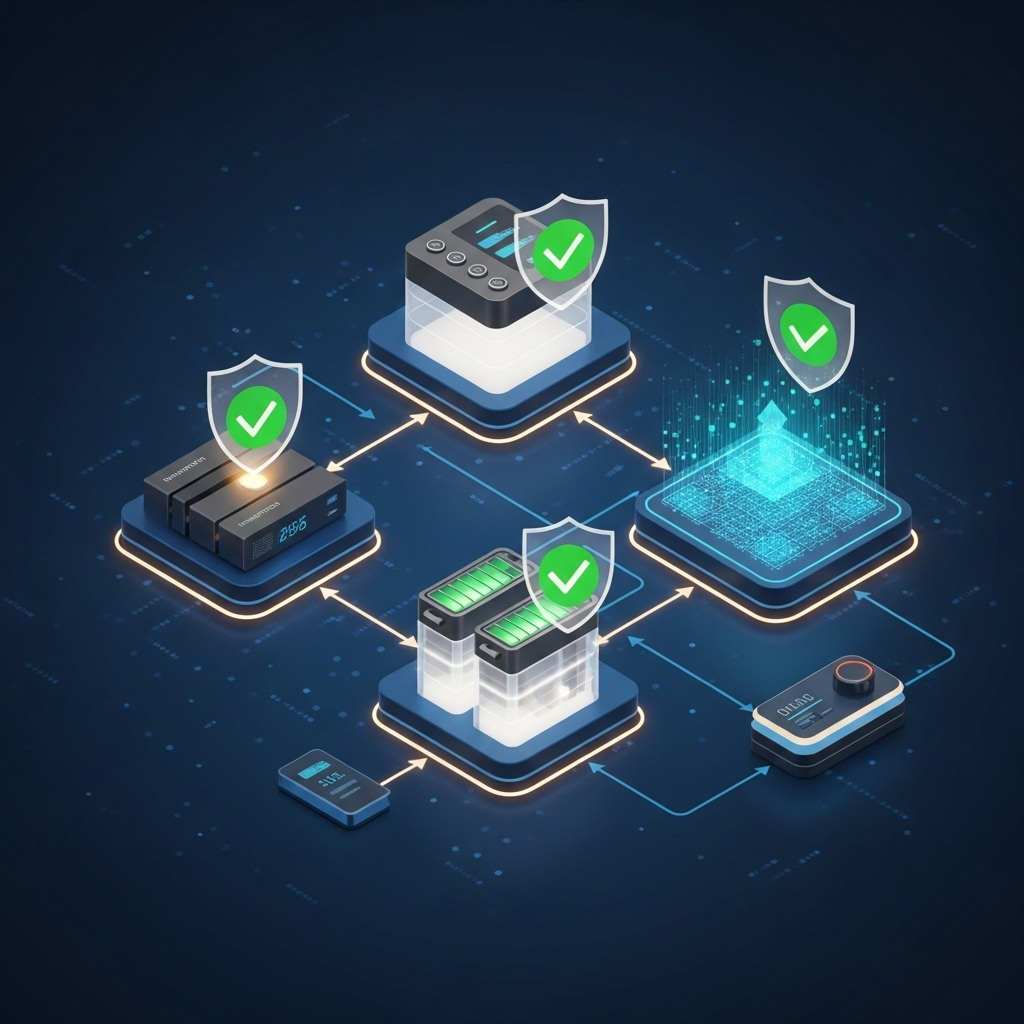Effective remote monitoring is the backbone of any reliable Energy Storage System (ESS). It provides the critical visibility needed to ensure performance, security, and longevity. When selecting a monitoring solution, the choice often comes down to two primary options: vendor-specific portals and Supervisory Control and Data Acquisition (SCADA) systems. Each approach offers distinct advantages and is suited for different applications. Understanding their differences is key to managing your energy assets effectively and securing your energy independence.
What Are Vendor Portals? The Plug-and-Play Approach
Vendor portals are software platforms developed by the hardware manufacturer. They are designed to work seamlessly with their specific inverters and batteries. This approach prioritizes simplicity and a user-friendly experience, making it a popular choice for many system owners.
Simplicity and Ease of Use
The main appeal of a vendor portal is its straightforward nature. The interface is typically clean, with pre-configured dashboards displaying the most important information. Setup is minimal, as the software is already designed to communicate perfectly with the hardware. This makes it an excellent option for residential and small commercial users who need reliable monitoring without a steep learning curve.
Core Functionalities
Most vendor portals provide a solid set of features for day-to-day management. You can expect to see real-time data on battery state of charge (SoC), power generation from solar panels, and energy consumption. They also offer historical data analysis, basic performance alerts, and a streamlined process for receiving critical firmware updates directly from the manufacturer. As noted in an IRENA report on grid codes, modern energy components are equipped with digital interfaces that enable remote supervision and the installation of software updates, a function that vendor portals facilitate.
Limitations to Consider
The simplicity of vendor portals comes with trade-offs. You are operating within a 'walled garden,' meaning you cannot integrate equipment from other manufacturers. Customization is limited to what the vendor offers, and you are dependent on their development roadmap for new features. Data ownership can also be a concern, as your system's performance data is stored on the vendor's servers, which might limit your ability to perform independent, in-depth analysis.
Understanding SCADA Systems: The Power of Customization
SCADA systems are a significant step up in complexity and capability. Originating in industrial control environments, SCADA provides a powerful framework for monitoring and controlling large, complex, and geographically dispersed systems. For large-scale ESS deployments, it is often the standard choice.

What is SCADA?
SCADA stands for Supervisory Control and Data Acquisition. It is not a single product but a type of system architecture that uses sensors, controllers, and software to gather and process data, as well as send control commands to connected equipment. An IEA report on system integration highlights that SCADA systems have been one of the most important tools for 'smartening' local grids, increasing observability and allowing for better management of bidirectional energy flows.
Unmatched Flexibility and Scalability
The primary advantage of SCADA is its flexibility. A well-designed SCADA system is vendor-agnostic, meaning it can communicate with and control hardware from many different manufacturers. This is essential for large projects that may use various types of inverters, batteries, and sensors. It is also highly scalable, capable of managing a single, complex site or an entire fleet of distributed energy assets from a central location.
Advanced Control and Data Analysis
SCADA provides a level of control that vendor portals cannot match. Operators can fine-tune system parameters in real time to optimize performance or respond to grid events. It also allows for comprehensive data logging and analysis. You own the data and can use it for predictive maintenance, performance modeling, and detailed financial reporting. This granular control is vital for maximizing the return on investment for large-scale energy assets.
Head-to-Head Comparison: SCADA vs. Vendor Portals
Choosing the right system depends on a clear understanding of their differences. The following table breaks down the key characteristics of each approach.
| Feature | Vendor Portal | SCADA System |
|---|---|---|
| Setup & Complexity | Simple, often plug-and-play | Complex, requires specialized engineering and integration |
| Customization | Limited to vendor-provided dashboards and features | Highly customizable to specific operational needs |
| Scalability | Best for single systems or small fleets | Ideal for large, multi-site, and utility-scale deployments |
| Cost | Low initial cost, often included with hardware | High initial investment in software, hardware, and labor |
| Data Ownership | Data typically stored and controlled by the vendor | Data is owned and controlled by the system operator |
| Security | Managed by the vendor; user has limited control | User is responsible for implementing a robust security framework |
| Multi-Vendor Integration | Not supported; locked into a single ecosystem | Core strength; designed to integrate diverse equipment |
Key Considerations for Your ESS Application
The right choice is not about which technology is superior overall, but which is appropriate for your specific needs. The scale of your project and your operational requirements will guide your decision.
For Residential and Small Commercial Users
For most homeowners and small businesses, a vendor portal is the most practical and cost-effective solution. The ease of use, low cost, and sufficient feature set provide all the necessary tools for monitoring system health and performance. The convenience of receiving automatic firmware updates and support directly from the manufacturer adds significant value.
For Large Commercial and Utility-Scale Projects
For large-scale applications, a SCADA system is almost always a necessity. The ability to integrate hardware from multiple vendors, the need for customized control logic, and the requirement to manage vast amounts of data make SCADA indispensable. These projects require a level of control and data ownership that vendor portals are not designed to provide.
The Importance of Firmware and Security
Both platforms are conduits for ESS remote monitoring and firmware updates. With a vendor portal, you trust the manufacturer to manage security and vet updates. With a SCADA system, the responsibility for securing the network and validating firmware falls to your team. This requires a higher level of in-house expertise but offers more control over your security posture.
Making the Right Choice for Energy Independence
Ultimately, the decision between a vendor portal and a SCADA system hinges on your project's scale, complexity, and long-term goals. A vendor portal offers a simple, accessible entry point for monitoring your energy assets. A SCADA system provides a powerful, customizable platform for professional asset management. Whichever path you choose, the objective remains the same: to maintain clear visibility and control over your system. This oversight is fundamental to ensuring reliability and achieving true energy independence. A deep understanding of your system's operational data, including key metrics outlined in this ultimate reference for solar storage performance, allows you to maximize its value over the long term.
Frequently Asked Questions
Can I switch from a vendor portal to a SCADA system later?
Yes, this is often possible, especially if your hardware supports standard communication protocols like Modbus or DNP3. However, migrating to a SCADA system is a significant project that requires investment in new software, hardware, and integration expertise. It is best to plan for your long-term needs from the outset.
Do vendor portals offer any control, or just monitoring?
Most modern vendor portals offer limited remote control capabilities. This typically includes changing the system's operating mode (e.g., self-consumption, time-of-use optimization, backup power) or remotely starting and stopping the system. Granular control over specific inverter or battery parameters is usually reserved for SCADA systems.
What security protocols are essential for a SCADA system?
Securing a SCADA system is critical. Essential practices include using Virtual Private Networks (VPNs) for remote access, implementing strong firewalls, enforcing role-based access control (RBAC) to limit user permissions, using encrypted communication protocols, and conducting regular security audits and penetration testing to identify and address vulnerabilities.





Leave a comment
All comments are moderated before being published.
This site is protected by hCaptcha and the hCaptcha Privacy Policy and Terms of Service apply.